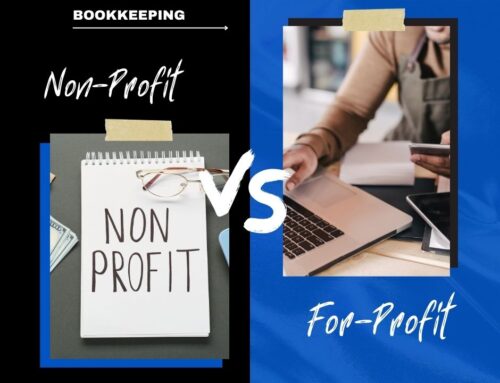Most people don’t start nonprofit organizations to record bookkeeping transactions and stare at financial reports. But accurate bookkeeping is necessary if you want your nonprofit to survive.
I created this guide to give you a better understanding of how to set up a bookkeeping system for nonprofits.
Once you have a firm grasp on these essential nonprofit bookkeeping principles, you can spend more time focusing on the greater mission of your organization.
Getting Started: What You Need for Nonprofit Bookkeeping
In many cases, nonprofits elect a financial officer or treasurer to manage all the finances for the organization.
This person, whoever they might be, needs to use specific tools to do the job correctly. Keeping a pile of unorganized paper receipts in a shoe box and using a personal bank account is not appropriate. Here’s what you need to get started:
Nonprofit Bookkeeping Software
The first thing you need to do is upgrade your software.
Lots of nonprofits that I consult with are using Excel spreadsheets or similar tools to keep track of everything. While this might be enough in the early days of your nonprofit, it’s not realistic for the long-term.
Get bookkeeping software that’s specifically intended for nonprofit organizations.
These tools have functions for organizing donation receipts and disbursements from your nonprofit. You’ll also be able to track basic bookkeeping elements like accounts receivables, accounts payables, petty cash, and payroll.
Fund Accounting Capabilities
Fund accounting is used by nonprofit organizations and government agencies. It’s a way to track and record money from different categories, as opposed to keeping everything in one cash account.
The reason why you need to keep these separate is because each funding source could have separate rules or restrictions in terms of time or purpose.
Large nonprofit organizations could have hundreds or thousands of different accounts. A university could have scholarships, endowments, operating funds, and funds for capital projects. Each one of these accounts will have different spending rules.
Separate Bank Account
This should go without saying, but you’d be surprised how many new nonprofit organizations fail to open a new bank account.
Never use your personal bank account to hold, disburse, or receive any money for your nonprofit. All transactions must go through a dedicated account for your nonprofit.
Talk to your bank and see if they have dedicated business checking accounts to accommodate nonprofits. These accounts typically come with lower fees compared to traditional business checking accounts.
Nonprofit Bookkeeping Tips and Tasks
After you take the three basic nonprofit bookkeeping steps that I’ve explained above, you’ll need to start performing specific bookkeeping tasks on a regular basis.
Here are a handful of tips and best practices for nonprofit bookkeeping.
Reconcile Bank Accounts
Once your account is opened and you’ve been making transactions, it’s important for you to reconcile your bank statements. This should happen at least once per month.
Bank reconciliation is the best way to ensure accurate nonprofit bookkeeping. You’ll be able to detect errors and prevent fraud if you do this on a regular basis.
Use Purchase Orders
There are strict rules for nonprofits about what they’re allowed to spend money on. You must have an organized system to ensure everything you purchase is fulfilled properly and falls within your budget.
The best way to do this is with a purchase order.
A purchase order is essentially a formal document sent from a buyer (your nonprofit) to a vendor. This document confirms the specifics of the goods or services in the transaction. It also makes sure that you and the supplier or vendor are on the same page.
Once a vendor signs a purchase order, it acts as a binding contract between both parties. It will explain exactly what you ordered, how much it costs, and when the delivery or fulfillment date is due.
Create a Budget
How much money can your nonprofit afford to spend on a particular event? What about goods and services? It’s impossible to know the answer to this without an annual operating budget.
Your budget will help you determine where and how your nonprofit will deploy resources. It acts as a financial roadmap, and will likely be adjusted throughout the year.
To determine your budget, you should have realistic estimates of your expected income and expected expenses. Figure out what you want to achieve for the year and allocate funds for specific instances.
Your nonprofit bookkeeping software (discussed earlier) should have tools for tracking funding and expenses compared to your budget.
Record In-Kind Donations
In-kind donations are contributions for goods, services, or time. In addition to cash, you also need to record any in-kind contributions received by your nonprofit.
Your books should have a separate income account for all non-cash donations.
For example, let’s say a lawyer volunteers five hours of their time to review and execute a contract, lease, or other legal documents for your nonprofit. This needs to be recorded as a gift.
The amount recorded will be based on fair market value. So, if that lawyer charges $125 per hour for a typical client, you would record those five hours as an in-kind donation of $625.
According to the IRS, you can determine the value of “fair market” on your own for goods, services, and time below $5,000. Any contribution above $5,000 should get a formal appraisal.
Financial Statements for Nonprofit Accounting
Like any business, your nonprofit needs to create financial statements.
These documents will give you a general overview of your money. This will help you make crucial financial decisions and determine if you’re on track for short-term and long-term goals.
Your nonprofit bookkeeping software can automatically generate financial statements for you.
Statement of Financial Position
The statement of financial position is basically a balance sheet for nonprofits. It’s a snapshot of your organization’s financials at any given moment.
A nonprofit organization does not have any owners. So, unlike a balance sheet, there is no “owner’s equity” portion of the financial equation. Instead, the formula for a statement of financial position looks like this:
Assets – Liabilities = Net Assets
You take all your nonprofit’s assets, subtract what you owe, and the net assets express what’s left over.
Statement of Activities
Nonprofit organizations do not have income statements. Instead, they have a statement of activities or an operating statement.
Like an income statement, this financial report will explain how “profitable” your organization was over a given period.
The residual amount from subtracting expenses from revenues flows over to the statement of financial position as net assets which are then classified as net assets without donor restrictions or net assets with donor restrictions.
Cash Flow Statement
As the name implies, a cash flow statement or statement of cash flows tracks all the cash for your organization.
Nonprofit cash flows are very similar to for-profit cash flow statements. It reports the change in an organizations’ cash and cash equivalents for an accounting cycle.
You can read more about cash flow statements in our guide for three financial reports for small business bookkeeping. This will give you additional insight to balance sheets and income statements as well. You can compare these to the nonprofit financial reports.
Conclusion
This beginner’s guide will put you on the right track for nonprofit bookkeeping.
But if you’re still lost or need some assistance, you should consult with an outsourced bookkeeping service specializing in nonprofits. This will give you more time to focus on your organization’s mission and less time worrying about the accuracy of your books.





